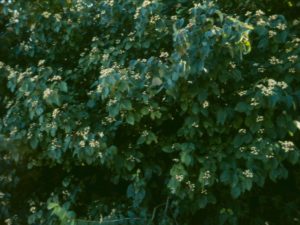Stratification of Shrub Seed
As with prairie seed, the purpose of stratifying our native shrub seed is to simulate going through a chill cycle so the embryo will sense that winter has come and gone, and warmer temperatures now mean that spring has arrived and it is time to grow. But for shrubs, the seed is embedded in a fruit designed to be eaten by birds and then dispersed across the landscape. So their stratification needs to also simulate the bird part of the cycle in order to properly set the embryo’s chemical clock for next winter and spring.
The fleshy edible part of the fruit as it ripens in late summer or early autumn provides a warm and moist environment for the seed within. To protect it from germinating while still on the bush, the flesh contains growth inhibitors designed to stop sprouting, without harming the critters attracted to eating it, including you and me. Thus the first step toward freedom to germinate is stripping away the fruit flesh by critters soon after it ripens, or the inhibitors may kill or damage the embryo.

Gray dogwood fruits in abundance, awaiting the arrival of flocks of cedar waxwings.
The body temperature of birds exceeds ours by some 5 – 7 °F, and the embryo is attuned to this also. As the fruit is macerated in the bird’s crop, the flesh is eroded away, taking the inhibitors with it and leaving clean seed. We simulate this step by soaking the fruit in warm water for 3-5 days, until the flesh gets mushy and then working the pulp through a metal screen or colander and wearing it down to clean seed.
Out in nature, the cleaned seed is defecated by the bird onto the ground, which is destined to get cold as autumn turns to winter. Snow and ice help keep the seed from drying out and protects it from predators. We simulate this by stratification: my preference is to spread the seed atop long fiber sphagnum moss dampened occasionally, but others use damp sawdust, sand, or other media. As with fine prairie seed, mold is the enemy, although some seeds with hard and glossy seed coats can tolerate a bit of mold. A key to preventing mold is to scrub the seed really clean on the screen, with a final scrub with dilute bleach. Slightly moldy seed can sometimes be rescued by rescrubbing with dilute bleach.
The seed is then winter stratified for at least two months, then plant the seed indoors or outside depending upon your post-germination plans. Some hard-coated seeds adsorb soil moisture slowly and take additional months to germinate after planting, especially if outdoors.
For large seed not eaten by birds – for example pawpaw or honey locust – you can skip the temperature part and just clean and stratify.
There is also an alternative plan for starting native shrubs. Simply clean the seed and plant it shallow in a sunny growing bed in autumn. The heat of the next summer will simulate the bird gizzard temperatures, and then the following winter will be the real thing for the seed.
It will germinate the next spring if it escapes the mice and voles. Making a little germination bed and covering it with ¼” mesh hardware cloth that extends down the sides to deter critters from burrowing under can save your seed.
Fruits that fall to the ground naturally can get their seeds cleaned by bugs, worms, and microbes, and can bypass birds by going through the above two-year germination cycle.
So if you planted some native shrub seed in your garden last spring and they didn’t grow, they may still be alive and working their way through the very specific two-year sequence that you imposed on them by bypassing the birds.


